
| 2 Jun, 2022 |
| GR Corolla
Morizo |
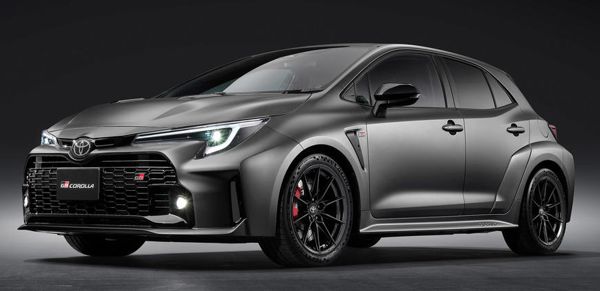 In 2007, Akio Toyoda was already the vice president of Toyota. To sharpen his own driving skill and train engineers, he formed Gazoo Racing and participated in Nurburgring 24 hours race. However, afraid of drawing criticisms from investors or the public for taking risks or placing personnal hobbies above company interests, he used the fake name Morizo Kinoshita to register the race. Since then, Morizo became his nickname in motorsport. Named after the nickname of big boss, the latest special edition of GR Corolla must be something special. Consider these:
The Morizo edition will be limited to only 200 units and bounded in America. Price is yet to be announced. |
| |
| 2 Jun, 2022 |
| Polestar 2
BST Edition 270 |
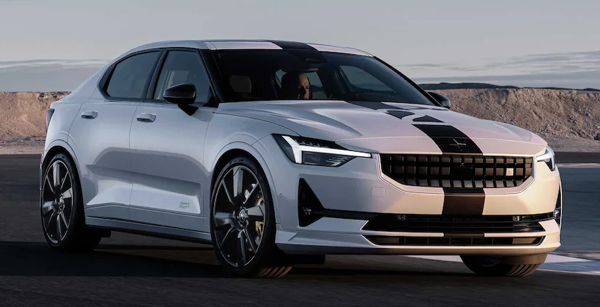 The BST Edition 270 is a faster and sportier Polestar 2. Like the recently updated Polestar 2 with Performance pack, its power and torque are lifted from 408 to 476 hp and 487 to 502 lbft, respectively, by means of only software update. However, the special edition gets also adequent chassis modifications, including a suspension that is 25mm lower and 20 percent stiffer (still uses Ohlins dampers), a front tower strut to reinforce the chassis, larger, 21-inch wheels and stickier P-Zero tires. Expect 0-60 mph improved to just over 4 seconds. Production is limited to 270 units worldwide. |
| |
| 1 Jun, 2022 |
| AMG One
finally goes into production |
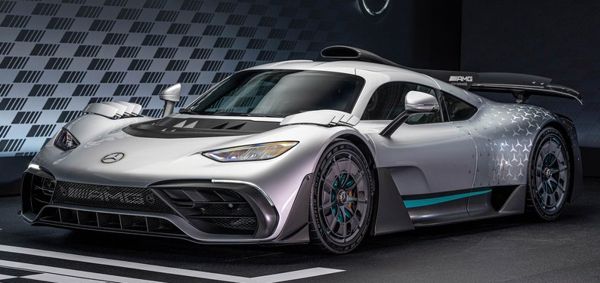 After a delay of 3 years, AMG One hypercar is finally entering production. When the working prototype was unveiled to the world in September 2017, Mercedes said it would take a further 18 months for development. That means it should enter production by mid-2019. Unfortunately, the concept of adapting Formula 1 powertrain to road use turns out to be far more problematic than first thought. AMG's engineers struggled to make it comply with emission standards, not least because an F1 engine idles at 5000 rpm. We are glad that the technical difficulties have been overcome eventually, though it comes with some side effects... The first is the poor timing of launch. When Mercedes F1 team is losing in this year's championship after a domination of 8 years, there can't be a worse time to launch a hypercar that is said to be transferring its F1 technology into road use. Anticlimax, in fact. Moreover, just when Mercedes has announced to stop making combustion engines by 2030 and turn all its attention to the electric future, what is the promotional value of this car? But worse still is the production car fails to deliver what it promised or was expected 3 years ago. Although top speed inches up from 350 to 352 km/h (219 mph), knocking off SLR Stirling Moss as the fastest ever Mercedes, its 0-200km/h (124mph) sprint time has been quietly lengthened from 6.0 to 7.0 seconds. That's a night and day difference, considering 6 seconds is in the same ballpark of Bugatti Chiron SS or just about any Koenigseggs, while 7 seconds struggles to keep up with the last generation of hypercars like McLaren P1 and LaFerrari, not even a standard production Ferrari SF90 which costs only a fraction of the AMG's €2.3 million pre-tax price. 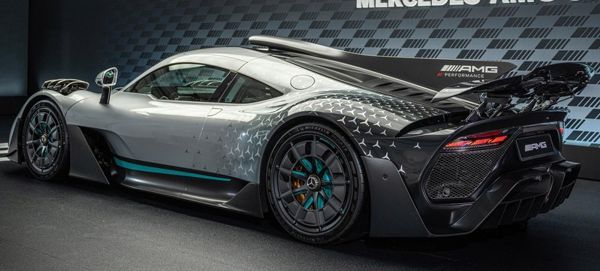 Remember the car was first rumored to come with a kerb weight of under 1000kg? Mercedes never confirmed nor denied that. When the prototype was unveiled 3 years ago, I was already one of the few estimating a kerb weight north of 1200kg. However, even that is proved to be optimistic. Now the official figure is 1695 kg DIN, much like an AMG sports saloon with V8 engine and steel body. That makes its all-carbon-fiber construction and engine-stressed-member design ridiculous. Part of the cause is the additional emission cleaning equipment, which consists of no less than 4 pre-heat metal converters, 2 ceramic converters and 2 particulate filters. Without them, it won't comply with EU6 emission standard. This means, the advantage of using a race-derived 1.6-liter V6 turbo engine is completely wiped off by the additional emission equipment, even though the exhaust sliencer is made of titanium. Another is the rather complicated electrical propulsion system. It has as many as 4 electric motors, one in the turbocharger, one behind the engine that drives the rear axle and 2 more at the front axle. Plus, the battery is quite large at 8.4kWh, 4 times the capacity of Mercedes F1 car, although not that much larger than those of SF90 (7.9kWh) or 918 Spyder (6.8kWh). The motors and electrical system weigh 320kg and the battery adds another 100kg. Failing to keep weight under control, no wonder the initial claims of 25km zero-emission range has been cut to 18.1km (11 miles), which is next to useless. 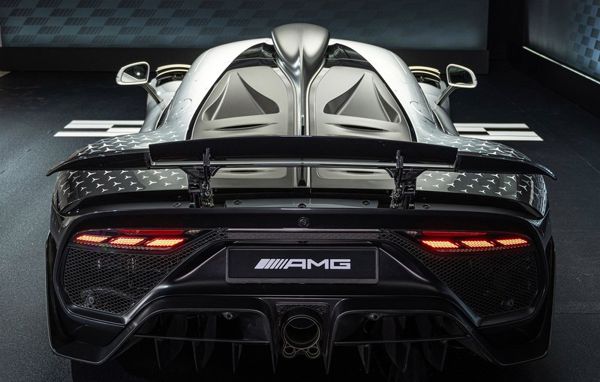 Body Otherwise, the production car is almost unchanged from the prototype, most notably its exterior. Shaped by aerodynamics and cooling needs like an endurance race car, it is long, low and wide but the cockpit section is narrow to reduce frontal area. The waistline is heavily scuplted fore and aft of the butterfly doors. The front fenders have movable ventilation louvres which open to release pressure built inside the wheel wells or close to reduce drag. Sandwiching the F1-style single exhaust is a pair of large diffusers. Above the tail is a retractable spoiler which extends upwards and tilts. Like a Le Mans race car as well, the fastback features a vertical fin and there are no rear windows, as the back is occupied by vents and NACA ducts, so it needs a rear-view camera. Mercedes provides no drag or downforce figures, but it should be good for serious track abuse. Chassis As expected, the AMG One is constructed around a carbon-fiber monocoque at which the powertrain is attached, and the latter is a stressed member for mounting the rear suspension. All suspensions have 5 links, and they employ pushrod-operating coil-over dampers and are interconnected between left and rear suspension. The dampers are adaptive, while ride height is adjustable by hydraulic depending on driving mode or speed. The car rides on Michelin Pilot Sport Cup 2R rubbers with bespoke compounds, sized 285/35ZR19 up front and 335/30ZR20 at the rear. The light forged alloy wheels - magnesium in option - are covered with carbon-fiber semi-aero seals. The ceramic brakes have 398mm discs and 6-pot calipers up front, 380mm discs and 4-pot calipers at the rear. 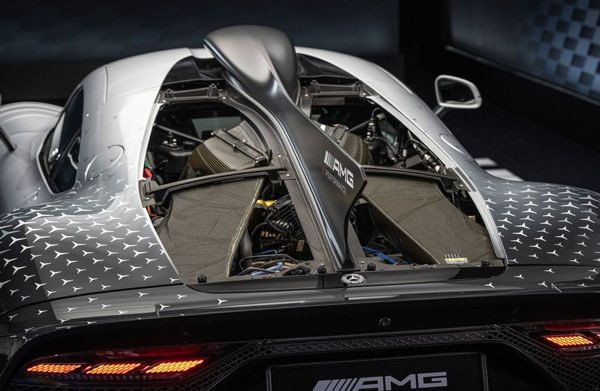 Powertrain The 1.6-liter V6 is built by Mercedes' F1 engine department in Brixworth, England, originally founded by Ilmor Engineering, so it won't feature the signature of an AMG technician. It shares many features with Mercedes F1 engines, including a 90-degree block in which a single exhaust gas turbo sits, an oversquared combusion chamber size of 80mm bore and 53mm stroke as well as pneumatic valve springs. No wonder it can rev to 11000 rpm. Strengthened cooling and lubrication give it a longevity worthy of a road-going engine, although it does need to be rebuilt every 50,000km. Like the current F1 engines as well, its big single-turbo has its compressor turbine and exhaust turbine separated by a long shaft so that one located at one end of the engine and another located at the other end. This avoids the heat transmitting from the exhaust side to the cold air side, ensuring better volumetric efficiency. The big turbo is assisted by an electric motor, or MGU-H (Motor Generator Unit-Heat) in F1 language, so that it can bring up to full speed in a fraction of a second to cut turbo lag. When back off, the motor works as a generator to reduce turbine speed to match the engine rev, recapturing the exhaust heat energy that would be otherwise lost through the wastegate. Another electric motor, or MGU-K (K for Kinetic) is mounted right behind the engine and works just like conventional hybrid, providing an additional 163hp to the rear axle through a step-down gear. Engine power transmits to the rear axle via an Xtrac 7-speed (single-clutch) automated manual gearbox (not the 8-speeder previously known), chosen for lightness and speed instead of refinement. There are 2 more motors at the front axle to provide extra push, giving all-wheel drive and torque vectoring functionality by the way. Each of the 3 propulsion motors produces 163hp and revs to 50,000 rpm like F1 motors, so they can work up to the car's top speed as long as battery level allows. 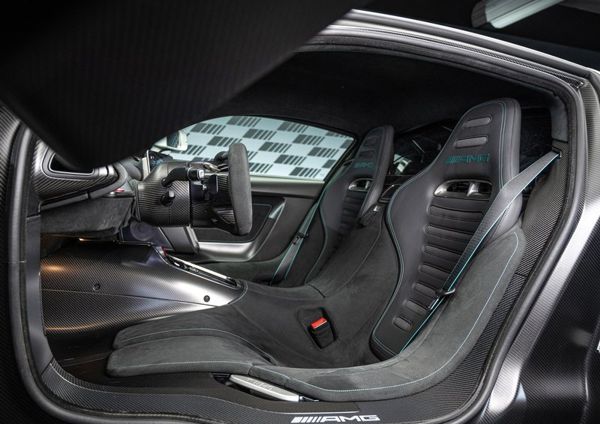 Performance At maximum boost pressure of 3.5 bar, the V6 engine produces 574 horsepower at 9000 rpm. That sounds a bit underwhelming for a hypercar engine, but you can't help amazed by its specific output of 359 horsepower per liter, which is by far the highest in road cars. For comparison, the M139 four-cylinder turbo on A45 S managed just 211 hp/liter. As the electric motors can work at any speed, the maximum combined output is simply the summation of engine and motor power, i.e., 1063 horsepower, while torque is too complicated to reveal, claimed AMG. Performance claims is 0-62 mph in 2.9 seconds, 124 mph in 7.0 seconds and 186 mph in 15.6 seconds. Considering German figures might be slightly conservative, that kind of performance is about comparable to Ferrari SF90. However, it is definitely no match for exclusive hypercars that it is expected to rival, such as Aston Martin Valkyrie, Koenigsegg Jesko, Rimac Nevera and Lotus Evija, all of which have significantly higher power to weight ratio. Besides, as a German car, the AMG One still owes us a Nurburgring lap time. Cockpit As the battery pack is located in the floorpan under the legs of driver and passenger, seating comfort is compromised. The seats are integral with the monocoque's floor, but the backrests, steering wheel and pedals are adjustable. It offers a pair of 10-inch LCD screens, one acting as instrument. The F1-style steering wheel is square and incorporates many controls, as well as an LED rev indicator at its top to help you judging shift time. Air-con, power windows and infotainment system are standard. The good news is... All 275 cars were already sold 3 years ago, so AMG needs not to worry the about facing its faster and newer rivals. However, if the car doesn't deliver the expected excitement on road, it could damage the reputation of AMG, just when the hot performance brand is making transformation to electrification. 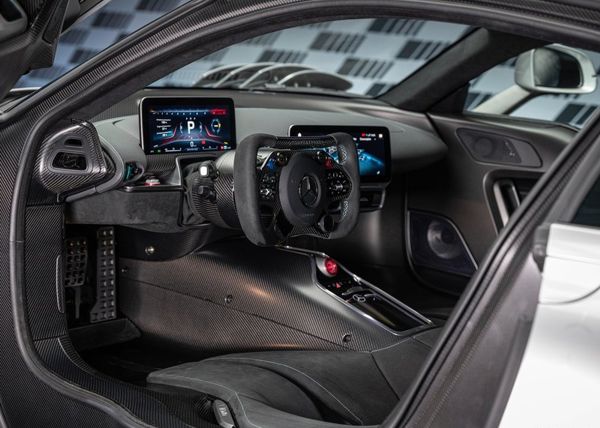 |
| |
